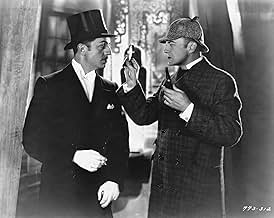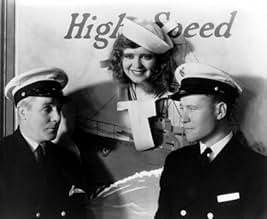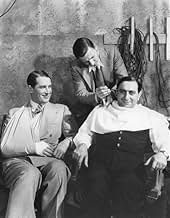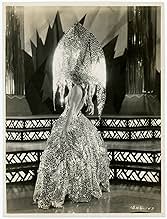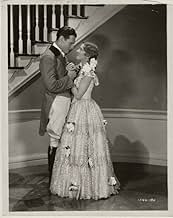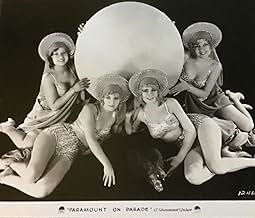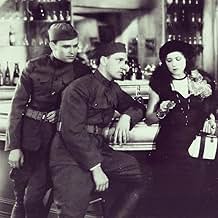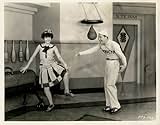Füge eine Handlung in deiner Sprache hinzuA musical revue that has Paramount stars and contract-players doing unrelated short sketches and elaborately staged song-and-dance numbers like a duet on a giant cuckoo clock and Clara Bow s... Alles lesenA musical revue that has Paramount stars and contract-players doing unrelated short sketches and elaborately staged song-and-dance numbers like a duet on a giant cuckoo clock and Clara Bow singing aboard a navy vessel.A musical revue that has Paramount stars and contract-players doing unrelated short sketches and elaborately staged song-and-dance numbers like a duet on a giant cuckoo clock and Clara Bow singing aboard a navy vessel.
- Regie
- Drehbuch
- Hauptbesetzung
- Auszeichnungen
- 3 wins total
Charles 'Buddy' Rogers
- Buddy Rogers - Episode 'Love Time'
- (as Buddy Rogers)
Empfohlene Bewertungen
I've just watched the current restoration and can add some information to the 2002 review.
The footage of the opening "Showgirls on Parade" sequence is missing but the sound survives.
The sound disc for "Isadore the Toreador" has been located (only a few days ago) and will be put into the next restoration with the surviving Technicolor footage..
Nino Martini's number is now complete, and in Technicolor.
The "Dream Girl" Technicolor footage survives but the sound is missing.
The "Gallows Scene" is missing most of the sound except for Dennis King's song.
The footage of the opening "Showgirls on Parade" sequence is missing but the sound survives.
The sound disc for "Isadore the Toreador" has been located (only a few days ago) and will be put into the next restoration with the surviving Technicolor footage..
Nino Martini's number is now complete, and in Technicolor.
The "Dream Girl" Technicolor footage survives but the sound is missing.
The "Gallows Scene" is missing most of the sound except for Dennis King's song.
Sad to say I recently saw an abbreviated version of Paramount On Parade with about only 60% of the numbers and acts in the edited version I saw. Fortunately I do remember seeing the whole film in years gone by.
Paramount's biggest star in those days was Maurice Chevalier who gets to be in three numbers, one of them being the finale. He also had the biggest hits of the show with All I Want Is Just One Girl and Up On Top Of A Rainbow. His third number the Poor Apache is an Apache number if Mack Sennett had choreographed it.
The White Mountain studio made both an English and French version and in the French version Jeanette MacDonald was mistress of ceremonies as opposed to comedian Skeets Gallagher for the English. She also was given a number in the French one that we in America weren't privileged to hear. I'm told it's quite lovely.
William Powell and Clive Brook play Philo Vance and Sherlock Holmes in a murder mystery satire where they annoy Warner Oland as Fu Manchu with insisting on dragging in other suspects. Eugene Palette and Jack Oakie are also in the skit as well.
Cut out of the version I just saw was Dennis King, Broadway star who had just repeated his role as Francois Villon in The Vagabond King. That film doesn't hold up well for a number of reasons, but his number Nichavo in Paramount On Parade is a stirring song that King's virile baritone takes to easily. King did much better on stage than on the screen although he scored very well in his next film with Laurel and Hardy, Fra Diavolo.
The finale is Maurice Chevalier with Up On Top Of A Rainbow done with a hundred chorus girls as well. The song and Maurice are fine, but these kind of numbers really needed Busby Berkeley to show how its done.
I'm a big old sucker for these all star films which had a brief run during the early days of sound and then were revived during World War II as morale boosters. I only wish a complete version was available out there.
Paramount's biggest star in those days was Maurice Chevalier who gets to be in three numbers, one of them being the finale. He also had the biggest hits of the show with All I Want Is Just One Girl and Up On Top Of A Rainbow. His third number the Poor Apache is an Apache number if Mack Sennett had choreographed it.
The White Mountain studio made both an English and French version and in the French version Jeanette MacDonald was mistress of ceremonies as opposed to comedian Skeets Gallagher for the English. She also was given a number in the French one that we in America weren't privileged to hear. I'm told it's quite lovely.
William Powell and Clive Brook play Philo Vance and Sherlock Holmes in a murder mystery satire where they annoy Warner Oland as Fu Manchu with insisting on dragging in other suspects. Eugene Palette and Jack Oakie are also in the skit as well.
Cut out of the version I just saw was Dennis King, Broadway star who had just repeated his role as Francois Villon in The Vagabond King. That film doesn't hold up well for a number of reasons, but his number Nichavo in Paramount On Parade is a stirring song that King's virile baritone takes to easily. King did much better on stage than on the screen although he scored very well in his next film with Laurel and Hardy, Fra Diavolo.
The finale is Maurice Chevalier with Up On Top Of A Rainbow done with a hundred chorus girls as well. The song and Maurice are fine, but these kind of numbers really needed Busby Berkeley to show how its done.
I'm a big old sucker for these all star films which had a brief run during the early days of sound and then were revived during World War II as morale boosters. I only wish a complete version was available out there.
Several scenes are still missing from this 1930 film, but what's left is mostly good stuff, and all interesting from a historical point of view. Would you like to see Clive Brook as Sherlock Holmes? Here's a rare chance. Would you like to see Clara Bow sing? Here she is. Would you like to see rather too many songs by Maurice Chevalier? Take your pick of several here. Would you like to see names such as Lillian Roth, Helen Kane, Mitzi Green, and Zelma O'Neill, who are only half-remembered today? Now you can. Would you like to see early appearances by William Powell and Fredric March before they made it big in talkies? They're in this.
The musical numbers fall into the 'ok' camp; they are largely static and stagey, and rather old-fashioned, but no more so than any other early talkie revue film. A lot of the film drags (notably Helen Kane's Boop-de-doop school lesson, and the links by Jack Oakie et al) but as a piece of history, it is fine. It should be a candidate for restoration if the whole film survives in a vault somewhere; let's hope so.
The musical numbers fall into the 'ok' camp; they are largely static and stagey, and rather old-fashioned, but no more so than any other early talkie revue film. A lot of the film drags (notably Helen Kane's Boop-de-doop school lesson, and the links by Jack Oakie et al) but as a piece of history, it is fine. It should be a candidate for restoration if the whole film survives in a vault somewhere; let's hope so.
Of the early talkie-era all-star revues, this one is by far the most "fun." The song sequences are nicely done; in particular, the "Dancing to Save Your Sole" segment with Nancy Carroll. Maurice Chevalier does very well in his three segments, one comedy segment, one comedy musical segment (bearing the noticable stamp of Lubitsch), and the entertaining finale. The comic segments are a bit hit or miss, but the Philo Vance/Sherlock Holmes/Fu Manchu skit near the start is a must-see. I saw this in an old TV print; the color sequences mostly exist, but have yet to be restored, and the copy of most prints that circulate is servicable, but not spectacular. Find the best print you can.
A couple of years into the Talkie revolution, several studios put on feature-length revues to promote their brand, of which Paramount's effort seems to have been better than most, even though it has not worn particularly well since. (Also the print I watched was notably fuzzy and dim.)
Deservedly, it gives generous exposure to Maurice Chevalier, who had just rescued the studio's fortunes with his Ruritanian romance 'The Love Parade', just as the Wall Street crash was threatening to ruin Hollywood. In particular, his energetic closing act, 'Sweeping the Clouds Away', accompanied by an endless line of leggy beauties, was clearly meant as a cheer-up call for the Depression-hit masses.
As for the other performers, I can only say that they remind us of the transience of fame (at a range of nearly a century). Not one in ten of these names mean anything to us today. Jack Oakie seems to occupy second place, and although I have often enjoyed his work, I think he was personality rather than artistry. Interesting to catch a glimpse of the young Frederick March. Otherwise, Gary Cooper, Clara Bow and Fay Wray more-or-less complete the roll of memorable stars.
Deservedly, it gives generous exposure to Maurice Chevalier, who had just rescued the studio's fortunes with his Ruritanian romance 'The Love Parade', just as the Wall Street crash was threatening to ruin Hollywood. In particular, his energetic closing act, 'Sweeping the Clouds Away', accompanied by an endless line of leggy beauties, was clearly meant as a cheer-up call for the Depression-hit masses.
As for the other performers, I can only say that they remind us of the transience of fame (at a range of nearly a century). Not one in ten of these names mean anything to us today. Jack Oakie seems to occupy second place, and although I have often enjoyed his work, I think he was personality rather than artistry. Interesting to catch a glimpse of the young Frederick March. Otherwise, Gary Cooper, Clara Bow and Fay Wray more-or-less complete the roll of memorable stars.
Wusstest du schon
- WissenswertesOf the original 20 individual sequences, seven of them were filmed in 2-strip Technicolor: the opening sequence: 'Showgirls on Parade', Nino Martini's 'Come Back to Sorrento,' Harry Green's 'Isadore the Toreador' with Kay Francis, Dennis King's 'Nitchavo,' 'Girl of My Dreams', with Richard Arlen, Jean Arthur, Mary Brian, Virginia Bruce, Gary Cooper, James Hall, Phillips Holmes, David Newell, Joan Peers, and Fay Wray, of which only the B&W introduction survives, and the 'Rainbow Revels' finale featuring Maurice Chevalier singing 'Sweeping the Clouds Away', which also survives in B&W. The total Technicolor footage was 2517 feet (768 m), or about 28 minutes.
- PatzerThe re-release opening credits credit producer Jesse L. Lasky as "Jessie" L. Lasky.
- Zitate
Jack Oakie: It's a mystery play written especially for me!
- Alternative VersionenVersion for distribution of the original film in Romania, titled Parada Paramount (1930) included additional sketches by Romanian actors Ion Ian-Covescu and Pola Iliescu
- VerbindungenAlternate-language version of Parada Paramount (1930)
- SoundtracksAll I Want Is Just One Girl
Music by Richard A. Whiting
Lyrics by Leo Robin
Sung by Maurice Chevalier
Sung also by Mitzi Green
Top-Auswahl
Melde dich zum Bewerten an und greife auf die Watchlist für personalisierte Empfehlungen zu.
- How long is Paramount on Parade?Powered by Alexa
Details
- Erscheinungsdatum
- Herkunftsland
- Sprachen
- Auch bekannt als
- Paramount Şeref Geçidi
- Drehorte
- Produktionsfirma
- Weitere beteiligte Unternehmen bei IMDbPro anzeigen
- Laufzeit1 Stunde 42 Minuten
- Farbe
- Seitenverhältnis
- 1.20 : 1
Zu dieser Seite beitragen
Bearbeitung vorschlagen oder fehlenden Inhalt hinzufügen

Oberste Lücke
By what name was Paramount on Parade (1930) officially released in India in English?
Antwort
